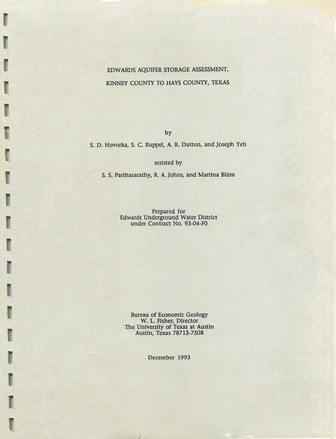Edwards Aquifer Storage Assessment, Kinney County to Hays County, Texas

| Author | Hovorka SD, Ruppel SC, Dutton AR and Yeh J |
| Year | 1993 |
| Description | Core- and log-based stratigraphic study of permeability, porosity and storativity in the Edwards Aquifer |
| Report Number | Contract 93-04-FO |
| Publisher | UT Austin Bureau of Economic Geology |
| Location | Edwards Aquifer, Balcones Fault Zone, San Antonio Segment |
| Cover | View Download |
| File | View Download |
| Summary |
|
The distribution of water in the Edwards aquifer was assessed using a core- and log-based stratigraphic study that included 200 neutron and resistivity logs and 300 porosity and permeability plug analyses. The Kainer, Person, Devils River, West Nueces, McKnight, and Salmon Peak Formations of the Edwards Group were investigated during this study. The aquifer extends over 3,111 mi2 (8,004 km2) and thickens toward the south from approximately 500 to 780ft (150 to 240 m). In the Edwards outcrop, the aquifer thins northward because of erosion and decreased saturated thickness. Porosity data were interpolated between wells to create a three-dimensional cell-based model of porosity. Porosity distribution reflects both the depositional rock fabric and later diagenesis. Small-scale vertical variations in porosity are the result of facies changes caused by high-frequency cyclidty In the depositional environment. Vertical facies stacking influences the amount of dolomitization and diagenetic enhancement of porosity. Subtidal fades deposited during major sea-level highstands are generally undolomltized and exhibit low porosity (4- to 12-percent porosity). Grainstones at cycle tops in the Kainer, Person, and Devils River Formations are typically high-porosity intervals with high depositional porosity that may have additional solution enlargement of pores and pore throats (20- to 42-percent porosity). Dolomltized subtidal facies have very high porosity in intervals with stacked tidal-flat cycles because of preferential dolomite dissolution. The average porosity of the Edwards aquifer in the study area is 21.7 percent. Variation in average porosity reflects depositional environment and possibly structural and hydrologic Influence on secondary porosity development and cementation. Low porosity is characteristic of the West Nueces and McKnight Formations of the Maverick Basin. The overlying Salmon Peak Formation has moderate to high porosity. In the Devils River, Kainer, and Person Formations, local high and low porosity Is encountered In structurally complex areas that may be related to variable ground-water flow rates and chemistry and consequent variations In pore enlargement or cementation. A high-porosity area is found in southern Medina and southwestern Bexar Counties on both sides of the saline-freshwater interface known as the bad water line. The total water-filled pore volume of the Edwards aquifer within the study area is 215 million acre-feet. The volume in the unconfined part of the aquifer, above the 1984 potentiometric surface, which is among the lowest ever recorded, Is 6.9 million acre-feet. Storativity of the confined part or the aquifer was estimated using barometric efficiency and net porosity. Barometric efficiency was calculated by comparing water-level hydrographs in nine observation wells with atmospheric pressure changes. The storativity calculated using this method averages 2.6 x 1Q-4. This approach has the potential for quantifying variations in storativity throughout the confined Edwards aquifer but must be verified by comparison with results of aquifer tests. Such data will improve prediction of how water levels will respond to withdrawal of water from the aquifer. |
Search for Documents
Advance Search
Explore EAA's Scientific Reports
- All Reports
- Water Use and Conservation
- Geochemistry
- Water Resources Planning and Management
- Floods and Drought
- Water Quality
- Climatology
- Surface Water / Groundwater Relationship
- Biology
- Springs, Groundwater Discharge
- Archaeology
- RZ Protection
- Aquifer Levels
- Remote Sensing
- Precipitation
- Overview Studies
- Modeling
- Hydrology and Hydrogeology
- History
- Groundwater Recharge, Recharge Zone
- Groundwater Movement
- Geomorphology and Caves
- Weather Modification
- Geology
